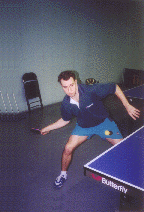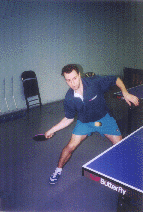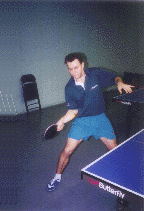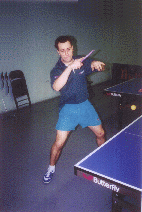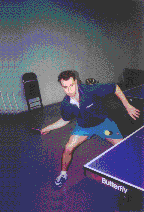|
|
||||||||||||||
|
|
||||||||||||||
|
|
LOOPING HEAVY BACKSPINBy Larry Hodges Heavy backspin-the very mention can strike terror in the hearts of even the best players. Even star players like Peter Karlsson of Sweden can have great difficulty with it. What's the problem, and how can it be overcome? First and foremost is the simple fact that since there aren't that many choppers, most players get minimal practice against heavy backspin. Players can practice looping against a heavy push, but a player then gets only one practice shot per rally, as opposed to many repetitive practice shots in each topspin drill (i.e. forehand to forehand, backhand to backhand, etc.). A second related problem is that even if a player does practice looping against a practice partner's push, the follow-up shot is normally a blocked return, so the player doesn't get to do repetitive practice, i.e., do the same shot over and over against the same spin until it becomes second nature. This is how players practice against topspin (forehand to forehand, backhand to backhand, etc.), but unless you have a chopper or a robot (or a coach feeding "multiball"), you can't do this against backspin. Both of these problems can be corrected by practicing on a Newgy robot. Even on its lower settings, its backspin is pretty heavy. Not only can you use the robot to learn the proper technique in looping this type of ball, but it will enable you to gain the confidence you need to make this shot in a game situation. How is the shot done? We will analyze a photo sequence of U.S. Olympic Team Member Todd Sweeris looping against a Newgy robot set on heavy backspin. (Speed setting was at 3.0.) He is looping at about medium speed —half his power goes to spin, half goes to speed. An interesting note is that when the various photos from the photo session were compared, Todd's stroke remained identical in each shot. Photos from the same part in each sequence looked so alike that they looked like copies from the same negative. (Editor's Note: There are 6 GIF files that Larry has included with this article. The first five are still pictures, and are great for studying the details of each phase of the stroke. The last picture is an animated GIF made from the 5 previous files. This file takes a while to load, but once loaded it will "play" all 5 still files in sequence, giving motion to the pictures and providing the viewer with a good idea of the "feel" of the motion and how one phase of the stroke leads into the next phase.) A close study of the photos show that Todd is generating power from nearly every part of his body—his legs, waist, shoulders, elbow, and wrist. Even his left shoulder generates force by pulling his body around through the ball. Looping is truly a "whole-body shot." Photo 1: Todd has bent his knees, especially his right one. Feet are well apart, giving him a firm stance. His right foot is parallel to the end-line of the table. He has dropped his right shoulder, and transferred most of his weight to his right foot—yet he is perfectly balanced. His waist is bent and twisted backwards. His playing arm, which he has straightened out somewhat, is pointed downward and backward. He has brought his wrist backward, so that the racket actually points backward. Both eyes are on the ball as he waits for ball to come into his hitting zone. Photo 2: Todd's right leg straightens out, beginning his body rotation into the ball. Right shoulder has begun to rise, while left shoulder is rotating backward—pulling his body around. Waist is untwisting and unbending. His wrist has begun to snap forward. Photo 3: Contact. Right shoulder has been pulled up, and both shoulders are rotating. Elbow and wrist are snapping through the ball. Most of the power is directed upward. Todd is still watching the ball with both eyes. (Against a faster incoming ball, he probably would not watch it as far in.) He has contacted the ball on the drop, about table level high. (For a slow, spinny loop, he'd let it drop more; for a faster loop, he'd contact it sooner. For a loop kill, he'd contact ball around the top of the bounce.) Contact is mostly a grazing motion. For a slow, spinny loop, ball should barely sink into the sponge. For more speed, ball sinks more into the sponge. Except for a loop kill, ball should not sink in so much that you hear the ball hit the wood of the racket. In Todd's case, you could barely hear the contact. Photos 4-5. The follow-through is up and forward, with both shoulders spinning around. (Because Todd has so much power on his loop, he is able to drive more forward against a heavy backspin than most players. Most players would follow through more upward, less forward. For a slower, spinnier loop, follow through higher; for a faster loop, more forward.) Elbow and wrist have snapped completely, with elbow now very bent. Most of his weight has transferred to his left leg, yet he remains balanced and ready for the next shot.
Courtesy of Newgy Industries Copyright © 2000 Newgy Industries. All rights reserved. |
|||||||||||||
|
Last Update : 06 November, 2002 Copyright © 2001-2006 Ertan Patir Webmaster : |

